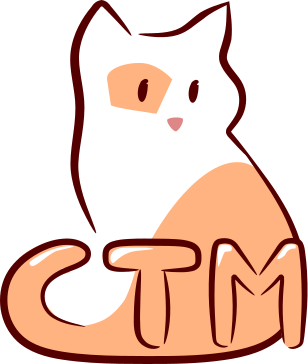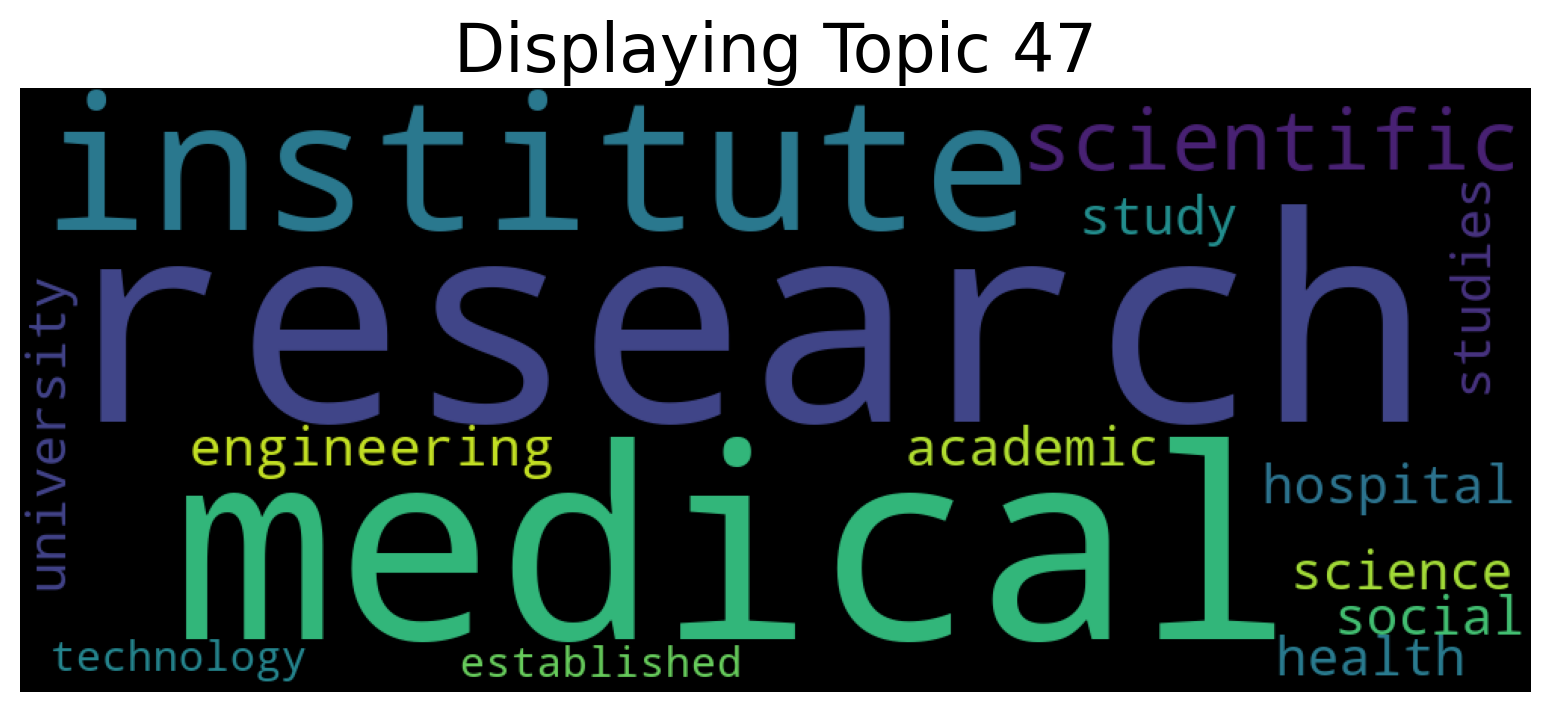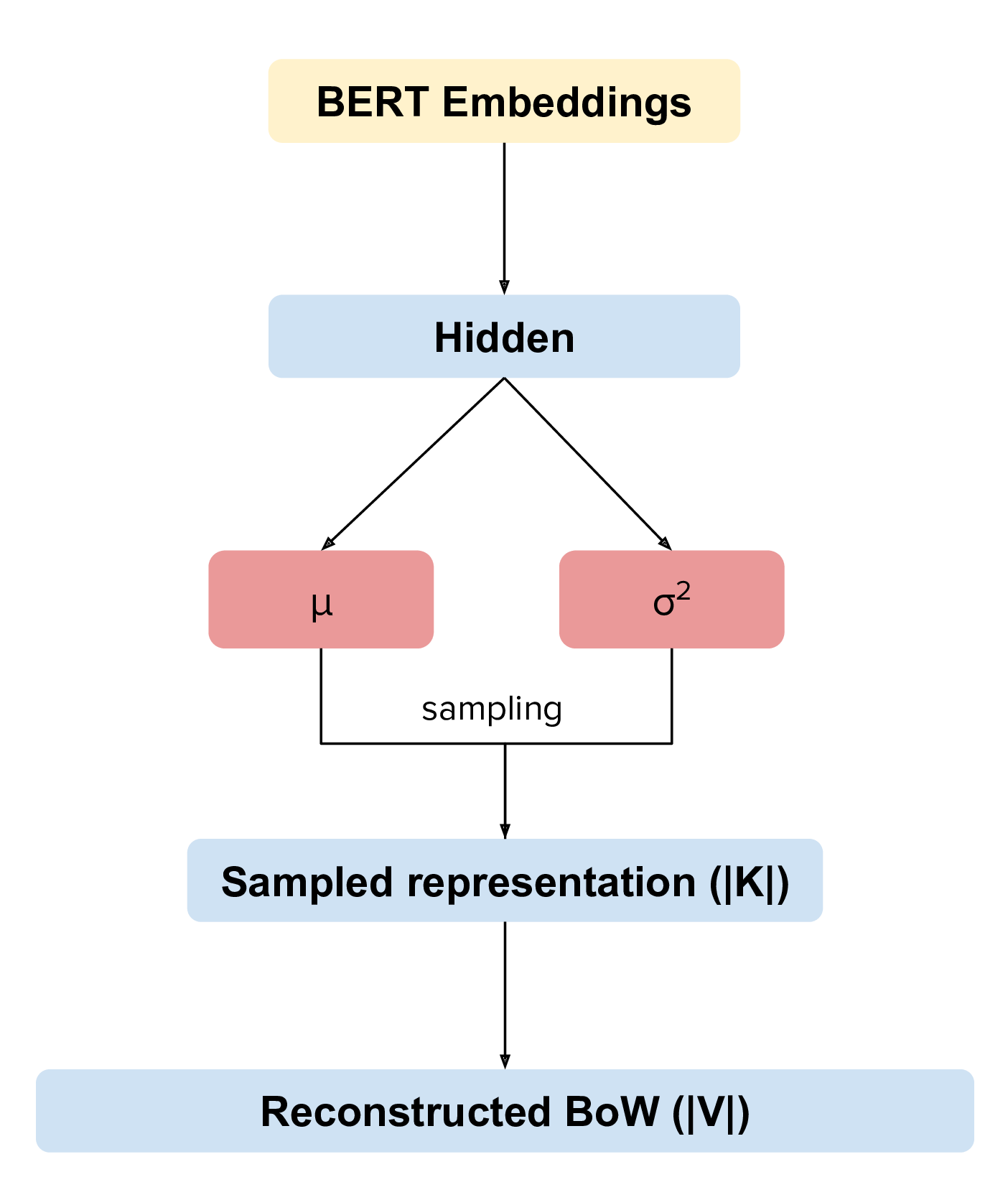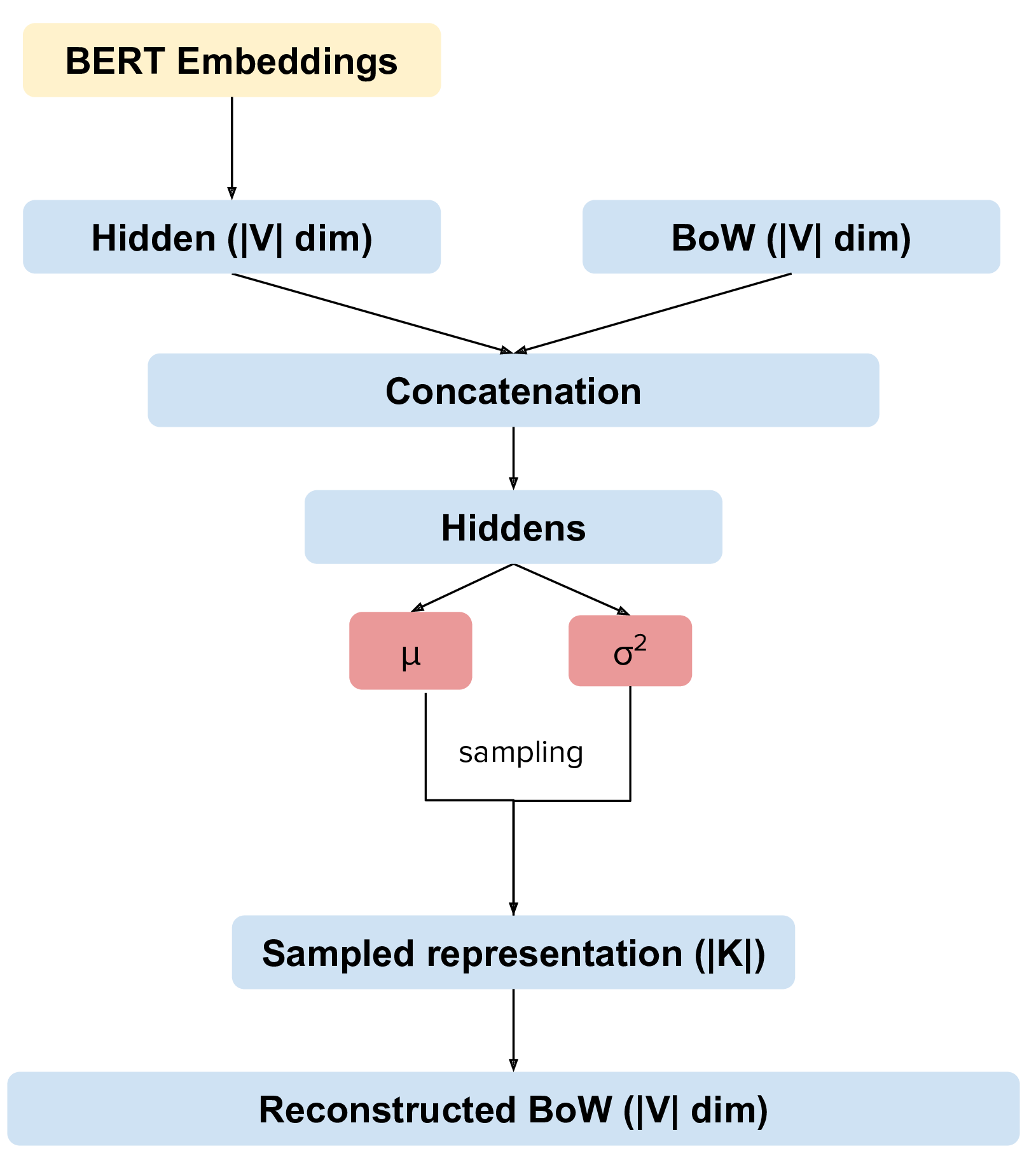Contextualized Topic Models
Project description
Contextualized Topic Models







Contextualized Topic Models (CTM) are a family of topic models that use pre-trained representations of language (e.g., BERT) to support topic modeling. See the papers for details:
Bianchi, F., Terragni, S., Hovy, D., Nozza, D., & Fersini, E. (2021). Cross-lingual Contextualized Topic Models with Zero-shot Learning. EACL. https://arxiv.org/pdf/2004.07737v1.pdf
Bianchi, F., Terragni, S., & Hovy, D. (2020). Pre-training is a Hot Topic: Contextualized Document Embeddings Improve Topic Coherence https://arxiv.org/pdf/2004.03974.pdf

README
Make sure you read the doc a bit. The cross-lingual topic modeling requires to use a ZeroShot model and it is trained only on ONE language; with the power of multilingual BERT it can then be used to predict the topics of documents in unseen languages. For more details, you can read the two papers mentioned above.
Jump start Tutorial
Name |
Link |
|---|---|
Zero-Shot Cross-lingual Topic Modeling (stable v1.8.0) |
|
CombinedTM for Wikipedia Documents (stable v1.8.0) |
|
CombinedTM with Preprocessing (stable v1.8.0) |
|
Zero-Shot Cross-lingual Topic Modeling (v1.7.0) |
|
CombinedTM for Wikipedia Documents (v1.7.0) |
TL;DR
In CTMs we have two models. CombinedTM and ZeroShotTM, which have different use cases.
CTMs work better when the size of the bag of words has been restricted to a number of terms that does not go over 2000 elements (this is because we have a neural model that reconstructs the input bag of word). This is NOT a strict limit, however, consider preprocessing your dataset. We have a preprocessing pipeline that can help you in dealing with this.
Check the contextual model you are using, the multilingual model one used on English data might not give results that are as good as the pure English trained one.
Preprocessing is key. If you give a contextual model like BERT preprocessed text, it might be difficult to get out a good representation. What we usually do is use the preprocessed text for the bag of word creating and use the NOT preprocessed text for BERT embeddings. Our preprocessing class can take care of this for you.
Software Details
Free software: MIT license
Documentation: https://contextualized-topic-models.readthedocs.io.
Super big shout-out to Stephen Carrow for creating the awesome https://github.com/estebandito22/PyTorchAVITM package from which we constructed the foundations of this package. We are happy to redistribute this software again under the MIT License.
Features
Combines Contextual Language Models (e.g., BERT) and Neural Variational Topic Models
Two different methodologies: Combined, where we combine BoW and contextual embeddings and ZeroShot, that uses only contextual embeddings
Includes methods to create embedded representations and BoW
Includes evaluation metrics
Includes wordclouds
Overview
Important: If you want to use CUDA you need to install the correct version of the CUDA systems that matches your distribution, see pytorch.
Install the package using pip
pip install -U contextualized_topic_modelsContextual neural topic models can be easily instantiated using few parameters (although there is a wide range of parameters you can use to change the behaviour of the neural topic model). When you generate embeddings with BERT remember that there is a maximum length and for documents that are too long some words will be ignored.
An important aspect to take into account is which network you want to use: the one that combines BERT and the BoW or the one that just uses BERT. It’s easy to swap from one to the other:
ZeroShotTM:
ZeroShotTM(input_size=len(qt.vocab), bert_input_size=embedding_dimension, n_components=number_of_topics)CombinedTM:
CombinedTM(input_size=len(qt.vocab), bert_input_size=embedding_dimension, n_components=number_of_topics)But remember that you can do zero-shot cross-lingual topic modeling only with the ZeroShotTM model. See cross-lingual-topic-modeling
Mono vs Multilingual Embeddings: Which Embeddings Should I Use?
All the examples below use a multilingual embedding model distiluse-base-multilingual-cased.
If you are doing topic modeling in English, you SHOULD use the English sentence-bert model, bert-base-nli-mean-tokens. In that case,
it’s really easy to update the code to support monolingual English topic modeling.
qt = TopicModelDataPreparation("bert-base-nli-mean-tokens")In general, our package should be able to support all the models described in the sentence transformer package and in HuggingFace.
Zero-Shot Cross-Lingual Topic Modeling
Our ZeroShotTM can be used for zero-shot topic modeling. It can handle words that are not used during the training phase. More interestingly, this model can be used for cross-lingual topic modeling! See the paper (https://arxiv.org/pdf/2004.07737v1.pdf)
from contextualized_topic_models.models.ctm import ZeroShotTM
from contextualized_topic_models.utils.data_preparation import QuickText
from contextualized_topic_models.utils.data_preparation import bert_embeddings_from_file
from contextualized_topic_models.datasets.dataset import CTMDataset
text_for_contextual = [
"hello, this is unpreprocessed text you can give to the model",
"have fun with our topic model",
]
text_for_bow = [
"hello unpreprocessed give model",
"fun topic model",
]
qt = TopicModelDataPreparation("distiluse-base-multilingual-cased")
training_dataset = qt.create_training_set(text_for_contextual, text_for_bow)
ctm = ZeroShotTM(input_size=len(qt.vocab), bert_input_size=512, n_components=50)
ctm.fit(training_dataset) # run the model
ctm.get_topics()As you can see, the high-level API to handle the text is pretty easy to use; text_for_bert should be used to pass to the model a list of documents that are not preprocessed. Instead, to text_for_bow you should pass the preprocessed text used to build the BoW.
Advanced Notes: in this way, SBERT can use all the information in the text to generate the representations.
Predict Topics for Unseen Documents
Once you have trained the cross-lingual topic model, you can use this simple pipeline to predict the topics for documents in a different language (as long as this language is covered by distiluse-base-multilingual-cased).
# here we have a Spanish document
testing_text_for_contextual = [
"hola, bienvenido",
]
testing_dataset = qt.create_test_set(testing_text_for_contextual)
# n_sample how many times to sample the distribution (see the doc)
ctm.get_doc_topic_distribution(testing_dataset, n_samples=20) # returns a (n_documents, n_topics) matrix with the topic distribution of each documentAdvanced Notes: We do not need to pass the Spanish bag of word: the bag of words of the two languages will not be comparable! We are passing it to the model for compatibility reasons, but you cannot get the output of the model (i.e., the predicted BoW of the trained language) and compare it with the testing language one.
Showing The Topic Word Cloud
You can also create a word cloud of the topic!
ctm.get_wordcloud(topic_id=47, n_words=15)
Combined Topic Modeling
Here is how you can use the CombinedTM. This is a standard topic model that also uses BERT.
from contextualized_topic_models.models.ctm import CombinedTM
from contextualized_topic_models.utils.data_preparation import QuickText
from contextualized_topic_models.utils.data_preparation import bert_embeddings_from_file
from contextualized_topic_models.datasets.dataset import CTMDataset
qt = TopicModelDataPreparation("bert-base-nli-mean-tokens")
training_dataset = qt.create_training_set(list_of_unpreprocessed_documents, list_of_preprocessed_documents)
ctm = CombinedTM(input_size=len(qt.vocab), bert_input_size=768, n_components=50)
ctm.fit(training_dataset) # run the model
ctm.get_topics()Advanced Notes: Combined TM combines the BoW with SBERT, a process that seems to increase the coherence of the predicted topics (https://arxiv.org/pdf/2004.03974.pdf).
More Advanced Stuff
Training and Testing with CombinedTM
training_dataset = qt.create_test_set(testing_text_for_contextual, testing_text_for_bow)
# n_sample how many times to sample the distribution (see the doc)
ctm.get_doc_topic_distribution(testing_dataset, n_samples=20)Can I load my own embeddings?
Sure, here is a snippet that can help you. You need to create the embeddings (for bow and contextualized) and you also need to have the vocab and an id2token dictionary (maps integers ids to words).
qt = TopicModelDataPreparation()
training_dataset = qt.load(contextualized_embeddings, bow_embeddings, id2token)
ctm = CombinedTM(input_size=len(vocab), bert_input_size=768, n_components=50)
ctm.fit(training_dataset) # run the model
ctm.get_topics()You can give a look at the code we use in the TopicModelDataPreparation object to get an idea on how to create everything from scratch. For example:
self.vectorizer = CountVectorizer() #from sklearn
train_bow_embeddings = self.vectorizer.fit_transform(text_for_bow)
train_contextualized_embeddings = bert_embeddings_from_list(text_for_contextual, self.contextualized_model)
self.vocab = self.vectorizer.get_feature_names()
self.id2token = {k: v for k, v in zip(range(0, len(self.vocab)), self.vocab)}Evaluation
We have also included some of the metrics normally used in the evaluation of topic models, for example you can compute the coherence of your topics using NPMI using our simple and high-level API.
from contextualized_topic_models.evaluation.measures import CoherenceNPMI
with open('preprocessed_documents.txt', "r") as fr:
texts = [doc.split() for doc in fr.read().splitlines()] # load text for NPMI
npmi = CoherenceNPMI(texts=texts, topics=ctm.get_topic_lists(10))
npmi.score()Preprocessing
Do you need a quick script to run the preprocessing pipeline? We got you covered! Load your documents and then use our SimplePreprocessing class. It will automatically filter infrequent words and remove documents that are empty after training. The preprocess method will return the preprocessed and the unpreprocessed documents. We generally use the unpreprocessed for BERT and the preprocessed for the Bag Of Word.
from contextualized_topic_models.utils.preprocessing import WhiteSpacePreprocessing
documents = [line.strip() for line in open("unpreprocessed_documents.txt").readlines()]
sp = WhiteSpacePreprocessing(documents)
preprocessed_documents, unpreprocessed_documents, vocab = sp.preprocess()Development Team
Federico Bianchi <f.bianchi@unibocconi.it> Bocconi University
Silvia Terragni <s.terragni4@campus.unimib.it> University of Milan-Bicocca
Dirk Hovy <dirk.hovy@unibocconi.it> Bocconi University
References
If you use this in a research work please cite these papers:
ZeroShotTM
@inproceedings{bianchi2020crosslingual,
title={Cross-lingual Contextualized Topic Models with Zero-shot Learning},
author={Federico Bianchi and Silvia Terragni and Dirk Hovy and Debora Nozza and Elisabetta Fersini},
booktitle={EACL},
year={2021}
}
CombinedTM
@article{bianchi2020pretraining,
title={Pre-training is a Hot Topic: Contextualized Document Embeddings Improve Topic Coherence},
author={Federico Bianchi and Silvia Terragni and Dirk Hovy},
year={2020},
journal={arXiv preprint arXiv:2004.03974},
}
ZeroShot Topic Model

Combined Topic Model

Credits
This package was created with Cookiecutter and the audreyr/cookiecutter-pypackage project template. To ease the use of the library we have also included the rbo package, all the rights reserved to the author of that package.
Note
Remember that this is a research tool :)
History
1.8.0 (2021-01-11)
novel way to handle text, we now allow for an easy usage of training and testing data
better visualization of the training progress and of the sampling process
removed old stuff from the documentation
1.7.1 (2020-12-17)
some minor updates to the documentation
adding a new method to visualize the topic using a wordcloud
save and load will now generate a warning since the feature has not been tested
1.7.0 (2020-12-10)
adding a new and much simpler way to handle text for topic modeling
1.6.0 (2020-11-03)
introducing the two different classes for ZeroShotTM and CombinedTM
depracating CTM class in favor of ZeroShotTM and CombinedTM
1.5.3 (2020-11-03)
adding support for Windows encoding by defaulting file load to UTF-8
1.5.2 (2020-11-03)
updated sentence-transformers version to 0.3.6
beta support for model saving and loading
new evaluation metrics based on coherence
1.5.0 (2020-09-14)
Introduced a method to predict the topics for a set of documents (supports multiple sampling to reduce variation)
Adding some features to bert embeddings creation like increased batch size and progress bar
Supporting training directly from lists without the need to deal with files
Adding a simple quick preprocessing pipeline
1.4.3 (2020-09-03)
Updating sentence-transformers package to avoid errors
1.4.2 (2020-08-04)
Changed the encoding on file load for the SBERT embedding function
1.4.1 (2020-08-04)
Fixed bug over sparse matrices
1.4.0 (2020-08-01)
New feature handling sparse bow for optimized processing
New method to return topic distributions for words
1.0.0 (2020-04-05)
Released models with the main features implemented
0.1.0 (2020-04-04)
First release on PyPI.
Project details
Release history Release notifications | RSS feed
Download files
Download the file for your platform. If you're not sure which to choose, learn more about installing packages.
Source Distribution
Built Distribution
Hashes for contextualized_topic_models-1.8.0.tar.gz
| Algorithm | Hash digest | |
|---|---|---|
| SHA256 | b3ad240e2a71ffb78705f7e0622d90276739b2f41e5dd74fcfb46a0bc6af16b9 |
|
| MD5 | 96f29961407835d68d1448167266e6a3 |
|
| BLAKE2b-256 | 93337d995048e14ccc920f0da4b9d25c4df78af870067dc44b037c67fdd30157 |
Hashes for contextualized_topic_models-1.8.0-py2.py3-none-any.whl
| Algorithm | Hash digest | |
|---|---|---|
| SHA256 | 76b8048af78bc35d84c7fbaff00fdc64fb96bfe37fecfd6a306146951c27389e |
|
| MD5 | af51ed12de08d514bd7098cbc20baf70 |
|
| BLAKE2b-256 | 34d72818f70daaf69783c779cc0274635bf8f1ac4fdb8831cb7ccfe567f58fa7 |











